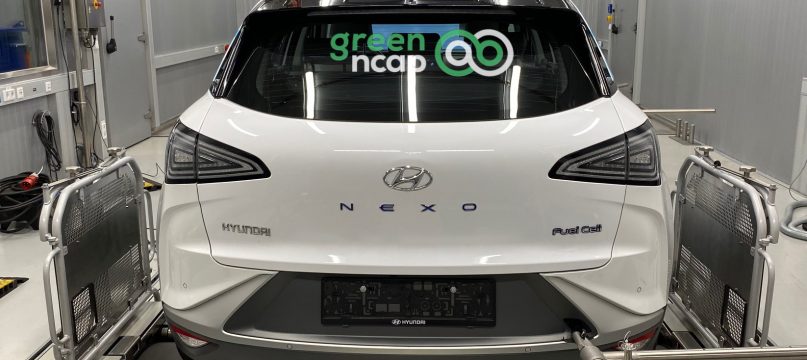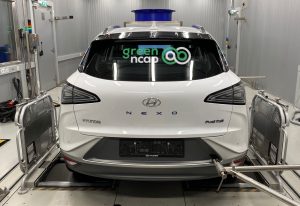


Today, Green NCAP announces the environmental performance ratings of 25 new cars including, for the first time, plug-in hybrid electric vehicles (PHEVs). The results of three – the Kia Niro, Mitsubishi Outlander and Toyota Prius – show that not all plug-in hybrids offer the same environmental benefits. The Hyundai NEXO – a hydrogen fuel-cell vehicle – demonstrates the promise of this developing technology. The list of tested cars also includes the full electric VW ID.3 and 19 combustion engine cars, of which two – the Škoda Octavia Combi 2.0 TDI and VW Golf 1.5 TSI – stand out from the rest.
When it comes to environmental cleanliness, pure electric vehicles outshine the competition and, with rising consumer interest, more and more traditional carmakers are getting serious about electric vehicles. Volkswagen’s first standalone electric car, the ID.3, reinforces this message, joining the BEVs previously tested by Green NCAP with a maximum 5-star rating. The Hyundai NEXO, a hydrogen fuel-cell car, also achieved 5 stars, as it proved to be just as clean as a battery electric vehicle and very nearly as energy efficient. Using a fuel-cell to convert hydrogen into electricity, the NEXO emits only water at the tailpipe and offers a driving range unmatched by any available pure electric vehicle, together with re-filling that is as quick and easy as a conventional car. The NEXO result clearly shows the huge potential of the technology, but fuel-cell cars are an obvious choice to most consumers only if sufficient hydrogen fuelling stations were available.
PHEV technology is currently much-favoured by manufacturers seeking to reduce their carbon footprint and comply with new emissions legislation. Marketed as offering “the best of both worlds” – battery-powered cleanliness when it is needed with the driving range of a combustion-engined car – Green NCAP’s tests revealed that, even when optimally charged, not all PHEVs are the same. Toyota’s Prius impresses most with a 4-star rating that beats all but pure electric and hydrogen fuel cell cars. The Kia Niro follows closely with 3½ stars, but the Mitsubishi Outlander only achieved 2 stars, less than some of the latest Euro 6 compliant petrol or diesel cars.
Euro NCAP Chairman, Niels Jacobsen, said, “People want independent, transparent information about the environmental impact of cars. These PHEV results show why that is so important. Consumers could be forgiven for thinking that, by buying a car labelled ‘PHEV’ and keeping it charged all the time, they will be doing their bit for the environment, but these results show that this is not necessarily the case. The Outlander shows that a big, heavy vehicle with a limited driving range is unlikely to offer any benefit over a conventional car. On the other hand, Toyota, with its long experience of hybrid technology, has done a terrific job and the Prius, properly used, can offer clean, efficient transport. It depends on the implementation and hybridisation strategy but what is true of all PHEVs is that they need to be charged regularly and driven as much as possible on battery power if they are to fulfil their potential.”
The Toyota Yaris Hybrid further underlines Toyota’s expertise in the field of electrification with a respectable 3½-star rating. But it is matched by two conventionally-engined cars, the diesel-powered Škoda Octavia Combi 2.0 TDI and the petrol-fuelled VW Golf 1.5 TSI. These are the best results achieved so far by non-electrified cars.
Niels Jacobsen, “Euro 6 legislation has made a real difference. For the first time, we’re seeing cars perform in real world driving the way they promise on the test bench and we should congratulate car manufacturers and emissions engineers for the huge strides they have made in the last few years. The future looks like it belongs to electric cars of one sort or another but, for now, consumers face a bewildering choice. Green NCAP is here to help them make informed decisions so that we can all contribute now to a cleaner, more sustainable future.”
All of the tests in this publication, expect those of the Toyota Prius, were sponsored by the European Commission as part of the Green Vehicle Index (GVI) project. The GVI program is a Horizon 2020 research program that will finish as of March and all further focus of development and testing will again be under the denominator ‘Green NCAP’. There will be three more releases in Jun, September and November 2021, all under the GNCAP brand.
Overview of all February 2021 results
| Audi A3 | 3 | stars | Mercedes-Benz A-Class | 2.5 | stars | |
| BMW 1 Series | 2.5 | stars | MINI Cooper | 2.5 | stars | |
| BMW X1 | 2 | stars | Mitsubishi Outlander | 2 | stars | |
| Citroën C3 | 3 | stars | Opel/Vauxhall Corsa | 2.5 | stars | |
| Dacia Sandero | 2.5 | stars | SEAT Leon | 3 | stars | |
| FIAT Panda | 2.5 | stars | Škoda Fabia | 3 | stars | |
| Ford Kuga | 2.5 | stars | Škoda Octavia | 3.5 | stars | |
| Honda Civic | 2.5 | stars | Toyota Prius | 4 | stars | |
| Hyundai NEXO | 5 | stars | Toyota Yaris | 3.5 | stars | |
| Hyundai Tucson | 1.5 | star | Volvo XC60 | 2 | stars | |
| Kia Niro | 3.5 | stars | VW Golf | 3.5 | stars | |
| Land Rover Discovery Sport | 1.5 | star | VW ID.3 | 5 | stars | |
| Mazda CX-30 | 2.5 | stars |
For full results, visit www.GreenNCAP.com.
For media information, please contact us at media@GreenNCAP.com.
Follow us online and on social media: